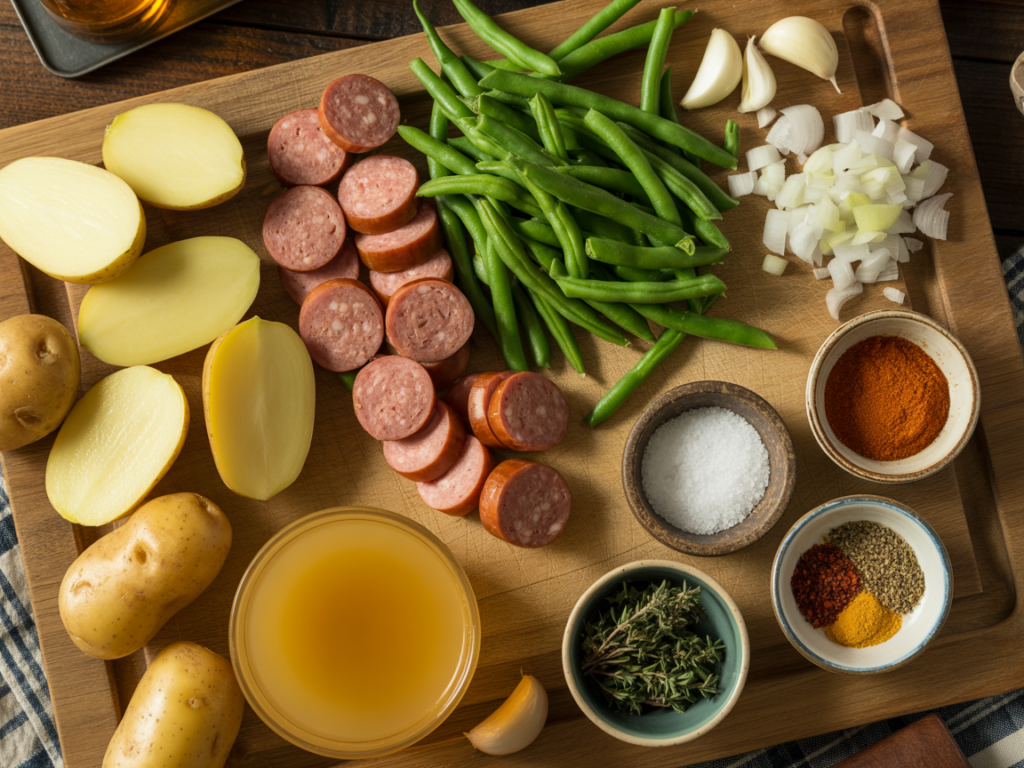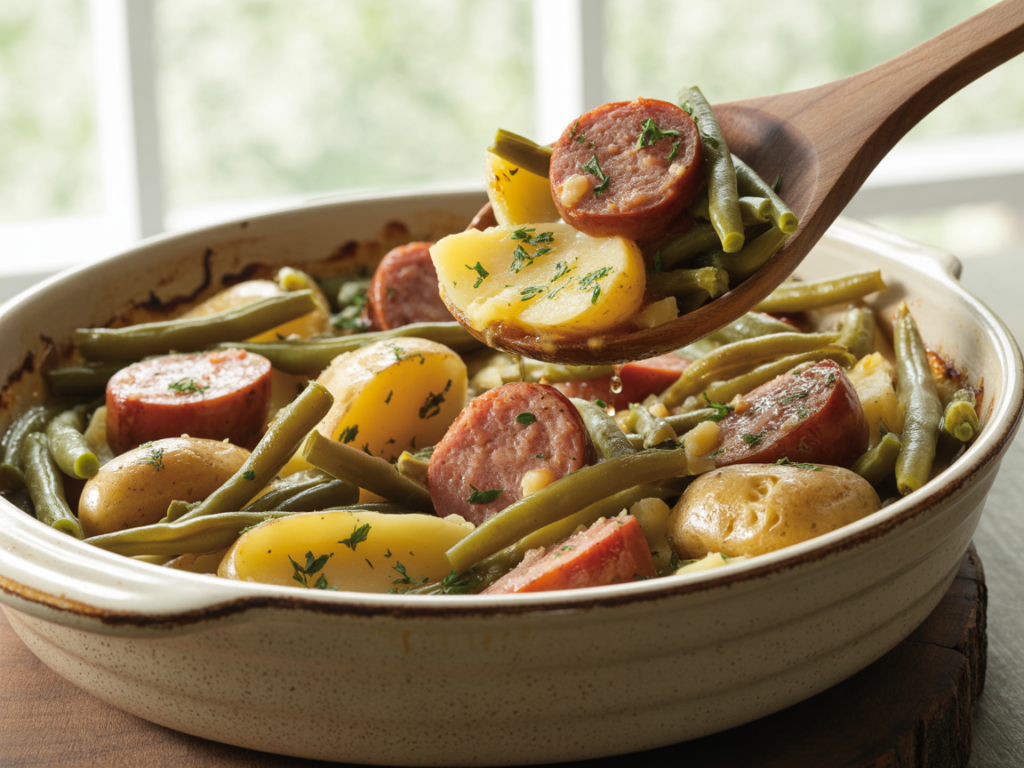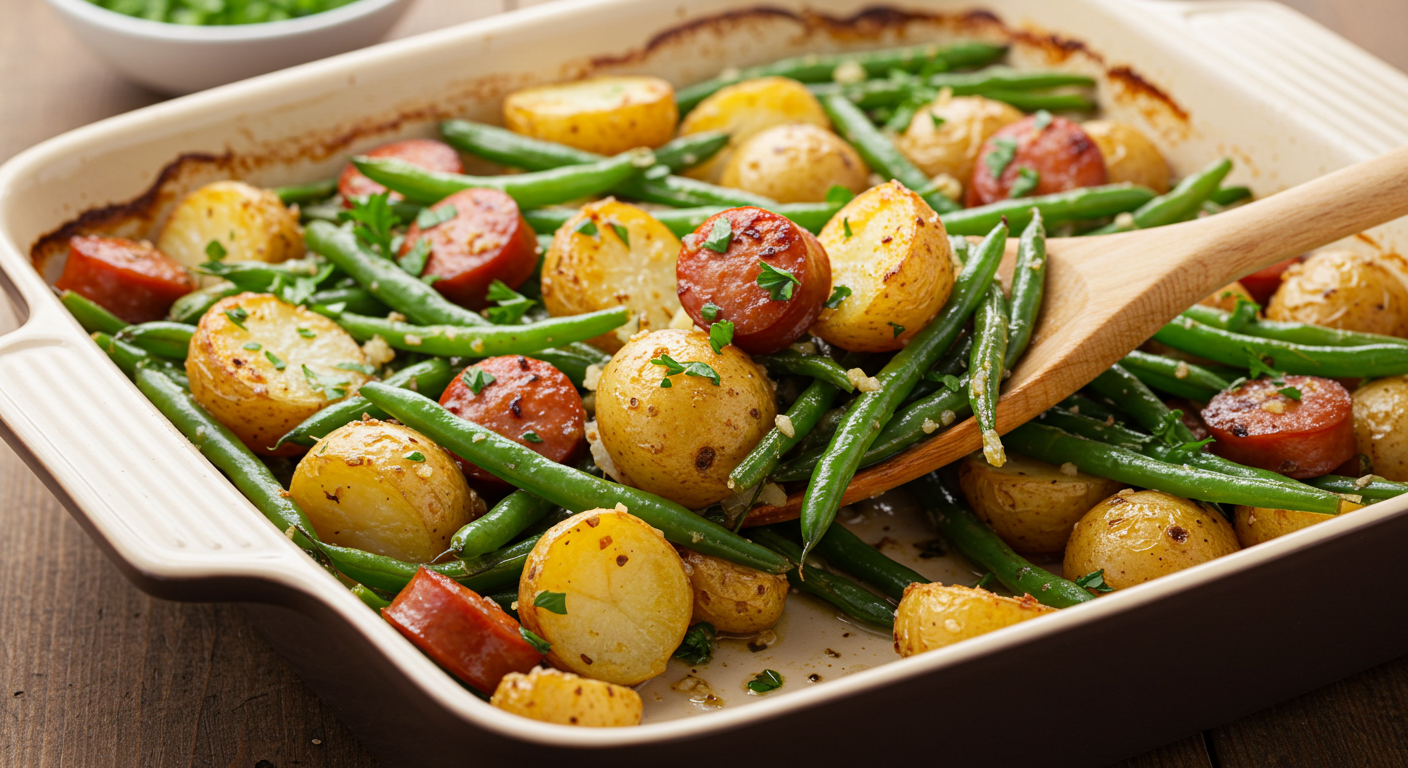
A Chef’s Journey Through Comfort and Tradition
Introduction: The Philosophy of the One-Dish Wonder
The humble casserole stands as one of culinary history’s greatest achievements—a testament to human ingenuity, resourcefulness, and our innate desire to create harmony from disparate elements. What appears at first glance to be a simple assembly of ingredients transforms, through the alchemical process of slow baking, into something transcendent: flavors meld, textures soften and crisp in perfect counterpoint, and aromas fill the home with promises of satisfaction and comfort.
In my twenty years as both a professional chef and passionate home cook, I’ve come to believe that the casserole represents the very essence of what cooking should be—a beautiful marriage of convenience and craftsmanship, of tradition and innovation. The Sausage Green Bean Potato Casserole I’m sharing with you today embodies this philosophy perfectly. It stands as a culinary bridge between generations, marrying the robust heartiness of kielbasa sausage with the earthy comfort of potatoes and the fresh vibrancy of green beans.
When I first developed this recipe during a particularly harsh winter in my New England farmhouse, I was seeking something that would not merely feed my family but nourish them on every level—body and soul. The result was this dish: substantial enough to serve as a complete meal yet versatile enough to complement a more elaborate spread, complex in flavor yet remarkably straightforward in preparation.
What makes this particular iteration special is the layering of flavors—the caramelization of the sausage, the careful seasoning of the potatoes, and the precise cooking of the green beans to maintain their texture and color. Unlike many casseroles that sacrifice individual ingredient integrity for cohesion, this one celebrates each component while creating something greater than the sum of its parts.
A Note on Ingredients: Quality, Substitutions, and Seasonality
The Sausage Selection
The foundation of this dish is the sausage, and while kielbasa is my preference for its particular balance of smoke, garlic, and spice, this recipe welcomes adaptation. Traditional Polish kielbasa offers an authentic character with its distinctive garlic and marjoram profile, but smoked andouille brings a Cajun influence with increased heat, while Italian sausage introduces fennel notes that play beautifully against the potatoes.
When selecting your kielbasa, look for quality indicators: a natural casing that snaps when bitten, visible specks of spice within the meat, and a proper balance of lean meat to fat (approximately 70/30). Artisanal butcher shops often produce superior versions, but many supermarket options are more than acceptable—just avoid those with excessive fillers and preservatives.
For those avoiding pork, turkey or beef kielbasa makes an excellent substitute, though you may want to add a touch more fat to the dish, perhaps through an extra tablespoon of butter or a drizzle of olive oil, to compensate for the leaner meat.
Potato Considerations
The choice of potato dramatically influences both texture and flavor. Baby creamer potatoes—those small, round, thin-skinned varieties—are ideal for several reasons. First, their high moisture-to-starch ratio allows them to remain tender without disintegrating during the baking process. Second, their concentrated potato flavor stands up well to the robust sausage. Finally, their size creates the perfect ratio of crisp exterior to creamy interior.
Should creamers be unavailable, small Yukon Golds make an excellent substitute with their buttery flavor, while fingerlings offer an interesting textural variation. Russets, while wonderful for many applications, tend to break down too much for this particular dish, creating a texture more akin to a shepherd’s pie than the distinct elements we’re seeking.
Whatever variety you choose, I recommend maintaining uniform size—halving or quartering as needed—to ensure even cooking. And never, under any circumstances, skip the step of tossing them in oil and seasonings before baking; this creates the crucial flavor foundation and helps develop the desirable exterior texture.
Green Bean Selection: Fresh, Frozen, or Canned?
While nothing matches the vibrant flavor and texture of fresh green beans at their peak, I recognize that seasonal availability and preparation time may dictate alternatives. Each option brings its own characteristics to the finished dish:
Fresh green beans offer superior texture with a pleasant snap and vibrant color. When available, particularly during late spring through early fall, they’re worth the extra preparation time. Select beans that are firm, bright green, and snap cleanly when bent. Trim only the stem end, leaving the pointed tip for visual appeal.
Frozen green beans provide a reasonable compromise, especially high-quality flash-frozen varieties. Their texture will be slightly softer, but their flavor remains true. Thaw completely and pat dry before adding to prevent excess moisture in the casserole.
Canned green beans should be your last resort, but they can work in a pinch. Their softer texture and slightly metallic taste are offset somewhat by the other robust flavors in the dish. If using canned, drain thoroughly and rinse under cold water to remove excess sodium before incorporating.
The Essential Equipment: Tools for Success
This rustic casserole doesn’t require specialized equipment, but a few quality tools will elevate your results:
- A heavy-bottomed sauté pan – Preferably cast iron, which provides even heat distribution for properly browning the sausage and aromatics.
- A sharp chef’s knife – For consistent cutting of vegetables and sausage, ensuring even cooking.
- A 9×13-inch baking dish – Ideally ceramic or enameled cast iron, which retains and distributes heat beautifully. Glass works well too, though metal pans may cause more sticking.
- Mixing bowls – While the recipe suggests using a gallon-sized bag for mixing (a convenient method), large mixing bowls offer better control and less environmental waste.
- Quality measuring tools – Particularly for the seasonings, where precision matters.
The Complete Ingredients List
For the casserole (serves 8):
- 1½ pounds kielbasa sausage, sliced into ¼-inch medallions
- 2 pounds baby creamer potatoes, halved (or quartered if larger)
- 1 pound fresh green beans, trimmed and cut into 2-inch pieces (or 2 15-ounce cans, drained)
- 3 tablespoons extra virgin olive oil
- 3 tablespoons unsalted butter
- 1 large yellow onion, finely diced (approximately 1½ cups)
- 5 garlic cloves, minced
- 1½ teaspoons sea salt
- 1 teaspoon freshly ground black pepper
- 1 teaspoon smoked paprika
- 1 teaspoon garlic powder
- ½ teaspoon dried thyme
- ½ teaspoon crushed red pepper flakes (adjust to taste)
- ¼ cup low-sodium chicken broth (or water)
- Fresh parsley, roughly chopped, for garnish
For optional enhancement:
- ½ cup aged Parmesan, grated
- 2 tablespoons high-quality extra virgin olive oil, for finishing
- Flaky sea salt, for serving
The Method: A Step-by-Step Culinary Journey
Preparation Phase
Begin by creating the proper environment. Preheat your oven to 400°F (205°C) and position a rack in the center. This temperature achieves the perfect balance—hot enough to create caramelization on the vegetables and sausage, yet not so hot that the exterior burns before the interior cooks.
Take a moment to prepare your workspace: gather all ingredients, measure your seasonings into small bowls (what professional chefs call “mise en place”), and ensure your cutting board is stabilized and your knife is sharp.
Preparing the Potatoes: The Foundation
The potatoes require special attention as they form the structural and flavor foundation of the dish. After washing them thoroughly under cold water to remove any soil residue, slice them in half—or quarters for any larger specimens—ensuring uniform size for even cooking.
Rather than using a plastic bag as mentioned in many recipes, I prefer to place the potatoes in a large mixing bowl. Add the olive oil and toss thoroughly to coat each piece with a thin, even layer—this prevents sticking and promotes browning. Now introduce your primary seasonings: 1 teaspoon sea salt, ½ teaspoon black pepper, the smoked paprika, and half of the garlic powder. Toss again until every potato piece gleams with seasoned oil.
Set these aside while you prepare the sausage, allowing the potatoes to absorb the seasonings—this brief marination period makes a noticeable difference in the final flavor.
Sausage Preparation: Developing Depth
A common mistake is adding raw sausage directly to the casserole, which results in a greasy final dish and underdeveloped flavor. Instead, place a heavy-bottomed skillet over medium-high heat and allow it to become properly hot—you should feel the heat radiating when you hold your hand an inch above the surface.
Add the sliced kielbasa in a single layer, working in batches if necessary to prevent overcrowding. The goal is to create a caramelized surface on both sides of each slice, developing those complex Maillard reaction flavors that will infuse the entire casserole. This should take about 2-3 minutes per side.
As you complete each batch, transfer the sausage to a paper towel-lined plate to drain excess fat. Reserve 1 tablespoon of the rendered fat in the pan for cooking the aromatics—this continues the layering of flavors that distinguishes a truly exceptional casserole.
The Aromatic Foundation: Onions and Garlic
In the same skillet with the reserved sausage fat, add the butter and allow it to melt completely. Add your diced onions along with ¼ teaspoon of salt—this small amount of salt helps draw moisture from the onions, accelerating the caramelization process.
Cook the onions over medium heat for 8-10 minutes, stirring occasionally, until they become translucent and develop a light golden color. Avoid the temptation to rush this step; properly caramelized onions create a sweet, complex foundation that elevates the entire dish.
Once the onions have reached the desired color, add the minced garlic and cook for just 60-90 seconds more—long enough to mellow its raw edge but not so long that it burns and becomes bitter. Remove the skillet from heat and allow the mixture to cool slightly.
The Green Bean Preparation
If using fresh green beans, bring a large pot of heavily salted water to a rolling boil. Prepare an ice bath in a large bowl. Add the trimmed green beans to the boiling water and cook for exactly 3 minutes—this brief blanching preserves their color and creates the perfect initial texture, allowing them to finish cooking in the casserole without becoming mushy.
Immediately drain and plunge the beans into the ice bath to stop the cooking process. Once cooled, drain thoroughly and pat dry with clean kitchen towels—excess moisture is the enemy of a well-textured casserole.
If using frozen beans, thaw completely and pat dry. For canned beans, drain, rinse thoroughly, and pat dry.
The Assembly: Creating Harmony
Now comes the moment of integration, where individual components become a cohesive dish while maintaining their distinct identities. In a large mixing bowl, combine the seasoned potatoes, caramelized sausage, sautéed onion-garlic mixture, and prepared green beans.
Add the remaining seasonings: ½ teaspoon salt, ½ teaspoon black pepper, the remaining garlic powder, dried thyme, and red pepper flakes. Gently fold everything together using a rubber spatula or wooden spoon, being careful not to break the potatoes. The goal is even distribution of ingredients and seasonings.
Transfer this colorful medley to a generously buttered 9×13-inch baking dish, spreading it in an even layer. Pour the chicken broth around the edges—this small amount of liquid creates steam during baking, helping to cook the potatoes while allowing the top layer to develop appealing textural contrast.
The Baking: Transformation Through Heat
Cover the baking dish tightly with aluminum foil—this initial covered baking period allows the potatoes to steam properly. Place in the preheated oven and bake for 30 minutes.
After 30 minutes, remove the foil and continue baking for an additional 15-20 minutes. This uncovered period is crucial for developing surface browning and creating textural contrast between the exterior and interior components.
The casserole is ready when the potatoes yield easily to a fork and the top layer has developed an appealing golden-brown color. If desired, during the final 5 minutes of baking, sprinkle the optional Parmesan cheese over the top for an extra layer of flavor and textural interest.
The Resting Period: Patience Rewarded
Once removed from the oven, allow the casserole to rest for 10 minutes before serving. This brief resting period allows the flavors to settle and the internal temperature to equalize, resulting in better texture and more cohesive flavor.
Just before serving, drizzle with the optional finishing olive oil, sprinkle with freshly chopped parsley, and add a light scattering of flaky sea salt if desired. These final touches add brightness, freshness, and visual appeal to the rustic dish.

Serving Suggestions and Accompaniments
While this casserole stands proudly as a complete meal, certain accompaniments can enhance the dining experience:
- A simple green salad with vinaigrette provides refreshing acidic contrast to the rich casserole.
- Crusty artisanal bread offers textural counterpoint and something to sop up the flavorful juices.
- A dollop of crème fraîche or sour cream adds creamy richness and tangy contrast.
- Quick-pickled red onions bring color and acidic brightness that cuts through the richness.
Wine Pairing Considerations
This hearty, savory dish pairs beautifully with several wine styles:
- Alsatian Pinot Gris offers body and subtle sweetness that complements the sausage’s smokiness.
- Oregon Pinot Noir provides earthy notes that echo the potatoes while offering enough acidity to refresh the palate.
- Austrian Zweigelt brings dark fruit flavors and pepper notes that enhance the dish’s savory qualities.
- For beer enthusiasts, a German dunkel or Czech amber lager provides malty sweetness and balanced bitterness.
Adaptations and Variations: Making It Your Own
The beauty of this casserole lies in its adaptability. Consider these variations to make it uniquely yours:
Seasonal Adaptations
- Spring: Substitute asparagus for green beans and add fresh peas during the final 15 minutes of baking.
- Summer: Add halved cherry tomatoes and yellow squash to brighten the dish.
- Autumn: Incorporate diced butternut squash and substitute sage for thyme.
- Winter: Add roasted brussels sprouts and a sprinkle of cranberries for holiday appeal.
Regional Variations
- Southern-style: Use andouille sausage, add okra, and incorporate Cajun seasoning.
- Mediterranean: Substitute chorizo for kielbasa, add roasted red peppers, and finish with crumbled feta.
- German-inspired: Use bratwurst, add caraway seeds, and serve with a side of sauerkraut.
- Italian twist: Incorporate Italian sausage, add cannellini beans, and finish with grated Pecorino Romano.
Make-Ahead and Storage Guidelines
This casserole adapts beautifully to busy lifestyles:
Make-ahead options:
- Prepare all components up to two days in advance, store separately in the refrigerator, and assemble just before baking.
- Assemble the entire casserole up to 24 hours before baking, cover tightly, and refrigerate. Allow an extra 10-15 minutes of baking time when starting from cold.
Storage:
- Refrigerate leftovers in an airtight container for up to 4 days.
- Freeze portions in freezer-safe containers for up to 3 months.
Reheating:
- For best texture, reheat in a 325°F oven until warmed through (approximately 15-20 minutes).
- Microwave individual portions for 2-3 minutes, though this may soften the textural contrasts.
A Final Reflection on Comfort and Connection
As we conclude this culinary journey, I’m reminded that casseroles like this one represent something far greater than mere sustenance. They embody our human desire for comfort, for integration, for turning simple ingredients into something nourishing on multiple levels.
When I serve this Sausage Green Bean Potato Casserole to friends and family, I’m sharing not just food but a piece of culinary heritage—one that bridges generations and creates new memories. The dish arrives at the table steaming and aromatic, inviting everyone to pause, gather, and connect over something created with care and attention.
In our rushed modern world, there’s something profoundly meaningful about a dish that asks us to slow down—both in its preparation and its consumption. The layered flavors reveal themselves gradually, rewarding mindful eating and conversation that spans the length of a meal rather than the mere minutes of hurried consumption.
Whether you’re preparing this for a holiday gathering, a Sunday family dinner, or meal prep for a busy week ahead, my hope is that you find both nourishment and joy in the process. Cooking, at its best, is an act of care—for ourselves and for those with whom we share our table. This rustic casserole, humble though it may be, carries that spirit in every bite.
Bon appétit!
Nutritional Information (Per Serving)
- Calories: 415
- Protein: 14g
- Carbohydrates: 22g
- Fat: 30g (9g saturated)
- Fiber: 3g
- Sodium: 780mg
Note: Nutritional values are approximate and may vary based on specific ingredients and brands used.





Interesting read. But dont you guys think that using seasonal veggies rather than canned ones would enhance the flavor of the casserole? I feel its worth debating about. Thoughts?
Interesting read! But wouldnt the casserole taste radically different if we substitute potatoes with sweet potatoes? I think it would really compliment the green beans and sausage. Thoughts?
Is anyone else curious about how the chefs journey through comfort and tradition influenced the recipe for the Sausage Green Bean Potato Casserole? Does the use of seasonal ingredients add to the authenticity?
Really enjoyed the read! However, isnt it arguable that using fresh seasonal ingredients could potentially alter the traditional taste of the Sausage Green Bean Potato Casserole? Thoughts?
Interesting read on the Sausage Green Bean Potato Casserole! Does the dishs comfort and tradition aspect outweigh the need for quality ingredients? And how much does seasonality impact the final taste?
Just a thought, but wouldnt the sausage green bean potato casserole be more versatile if it were deconstructed? Gives us all the option to play around with the ingredients, doesnt it?
Intriguing piece! But dont you think the chefs journey and the ingredients seasonality overshadow the actual dish? Why not have separate articles for each to give them the recognition they deserve?
Chefs journey sounds intriguing, but does the casserole hold up without potatoes?
Does the sausages quality affect the casseroles overall taste? Thoughts?